by Prof.
David N. Nikogosyan, University College Cork, Cork, Ireland
(click on photos to enlarge image)
MARKS OF EUROPEAN SILVER PLATE:
VI. WÜRTTEMBERGISCHE METALLWARENFABRIK (WMF)
GERMANY
Being in Budapest in 2003, I was amazed by the beauty of its
Art Nouveau buildings in the local "Secession" style. After
visiting one of such buildings on Ulloi street, 33-37, housing
the Museum of Applied Arts, I dropped into a small antique shop,
situated nearby, and "fell in love" with a gorgeous Art Nouveau
item, a silver-plated teapot with a black Ebony handle. This
item cost about 120 $, and I had not enough money with me. So, I
was forced to return back to my hotel (situated on the hills on
the opposite bank of the Danube), and then again back to the
shop for my purchase, which turned out to be my first WMF item.
WMF is the abbreviation for Württembergische Metallwarenfabrik,
which means Württemberg Metal Factory and was created in 1880 in
the small town of Geislingen on the river Steige (Geislingen an
der Steige), after the succesful merger of two smaller silver
plate foundries. This company is still active nowadays. The WMF
history is very well documented (see the references below), and
I am not going to repeat it here.
A teapot made by WMF between 1910 and 1918
|
This firm has an unbeatable reputation as a pioneer in
silver plate production of Art Nouveau items. The famous
Antiques Price Guide of Judith Miller (published annually by
Dorling Kindersley Ltd.) gives two whole pages for the
description of WMF metal ware Art Nouveau products. In this
catalogue no other European firm, active in this area in the
beginning of XX century, is mentioned, neither Christofle, nor
Arthur Krupp Berndorf, nor Wellner. The auction prices for WMF
pieces are also rather high. At the same time the silver coating
on WMF items is usually of much lower quality than that on the
products of the above-named firms. This could be explained by
the history of this foundry. Carl Haegele, head of a small
enterprise which was a predecessor to WMF, produced his first
electro-plated items rather late, in 1871. On the contrary,
Charles Christofle, already had in 1844 a similar technology in
operation. It should be also emphasized that WMF factory made a
lot of experiments with different base metals for silverplating,
which often turned out to be worse than common Alpacca.
Some WMF items from my collection: first row
(left) a milk can, (right) a sugar
bowl;
second row (left) a tea-glass holder,
(right) a sweet-dish with a glass inset;
third row (left) a creamer, (right) a
1922 coffee-pot with the inscription "Mitropa"
|
I have in my collection twenty silver-plated WMF
items with different marks. Below, I am presenting these marks,
used in the XIX-XX centuries. Though many WMF silver plate marks
were described earlier (in the references given below), I was
lucky to find some marks, which to the best of my knowledge were
never mentioned before.
WMF hollowware marks
|
N°
|
MARK
|
COMMENT
|
|
1
|






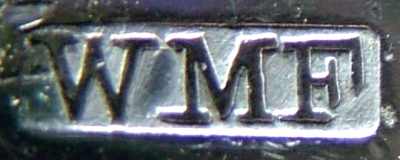
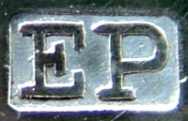
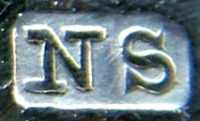
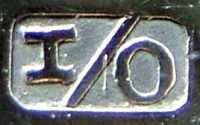



|
Marked by the inscription "WMF" (or
"W.M.F."), placed in a cartouche (sometimes a simplified lettering was
used without cartouche). Note the special shape of the "F" letter. The
length of "WMF" (or "W.M.F.") inscription is 4.6 - 5.8 mm, the ratio of the
inscription length to its' height is 3.8.
The additional marks: "EP" means "electro-plated", "NS"
means Neusilber (Alpacca) which is an indication of a
base metal for silver plating, "I/O" means normal silver
coating which is equivalent to 1 gram of silver per 1
dm2 of base metal surface, "as" means "antique finish".
Sometimes the inscription "WMF" is fused with the
additional "B" mark that means Britannia metal base (rare),
or with the "M" mark that means brass base (even more
rare) and after that the whole inscription looks as "WMFB"
or "WMFM" (photos from the Internet).
One of the earliest WMF marks, used from 1880 until around 1918.
Though quite common, it was never mentioned in literature.
|
|
2
|
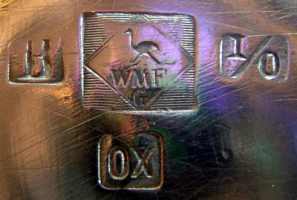
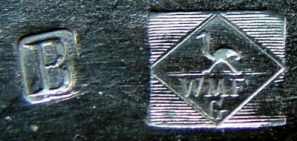
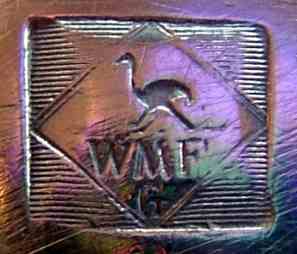
|
Marked by the ostrich and two inscriptions "WMF" and
"G" (Geislingen an der Steige) in a rhombus, placed in
hatched rectangle. Note the special shape of the "F"
letter. The rectangle size is 3.7 x 4.2 mm (or 3.7 x 4.4
mm).
The additional marks: "B" means Britannia metal, a
zinc-antimony-copper alloy which served as a base metal
for silver plating, "I/O" means normal silver coating
which is equivalent to 1 gram of silver per 1 dm2 of
base metal surface, "OX" means oxidized finish. This
mark was in use from around 1900 until about 1918.
|
|
3
|
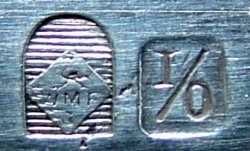
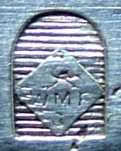
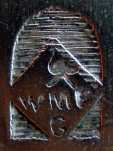
|
Marked by the ostrich and two inscriptions "WMF" and
"G" (Geislingen an der Steige) in a rhombus, placed in
hatched arch.
Note the simplified shape of the "F" letter.
The size of the arch varies from 1.8 x 2.4 mm to 3.7 x
5.2 mm.
The mark was used from 1909 until around 1914 for the
items exported to France.
|
|
4
|

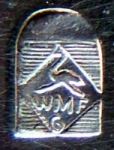
|
Marked by the ostrich and two inscriptions "WMF" and
"G" (Geislingen an der Steige) in a rhombus, placed in a
beehive with smooth round arch. Note the simplified
shape of the "F" letter. The beehive size is 2.1 x 2.3
mm. The size of the arch is 2.1 x 0.9 mm. Sometimes, the
smaller version of this mark is applied, with the
beehive size down to 1.2 x 1.3 mm and the arch size down
to 1.2 x 0.5 mm. The additional marks: "ALPACCA" is an
indication of a base metal for silver plating, "I/O"
means normal silver coating which is equivalent to 1
gram of silver per 1 dm2 of base metal surface. The mark
was used from 1910 until about 1918.
|
|
5
|
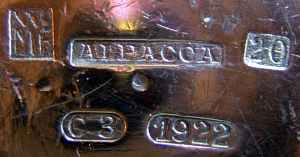
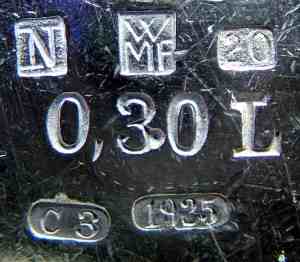
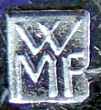
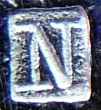
|
Marked by the inscription "WMF" placed in a
rectangle with indication of the production year. Note the characteristic cuts of the letters
"M" (top, right) and "F" (top, left).
The size of the rectangle is 2.0 x 2.4 mm or 2.2 x 2.4
mm.
The additional marks: "ALPACCA" or "N" (Neusilber which
means the same) is an indication of a base metal for
silver plating, "20" means an amount of silver metal (in
grams) used for silver plating, "1922" (or "1925") in a
cartouche means the year of production.
The mark was used from 1922 (or earlier) until 1925 (or
later).
This mark was never mentioned in the literature.
|
|
6
|
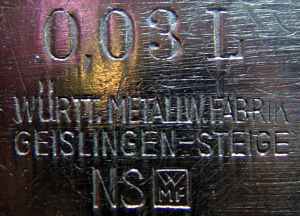
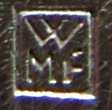
|
Marked by long inscription "WÜRTT. METALLW. FABRIK
GEISLINGEN-STEIGE" and by the abbreviation "WMF" placed
in a rectangle.
The rectangle size is from 1.2 x 1.3 mm to 1.4 x 1.6 mm.
The additional mark "NS" means Neusilber (Alpacca),
which is an indication of a base metal for silver
plating.
This mark was used between 1918 and 1925.
|
|
7
|


|
Marked by long inscription "WÜRTT. METALLW. FABRIK GEISLINGEN-STEIGE"
and by the abbreviation "WMF" placed in a beehive with dashed round arch.
The beehive size is mm 2.3 x 2.6 The size of the arch is mm 2.3 x 1.3. This mark was used from
1925 until 1935. Rare.
|
|
8
|
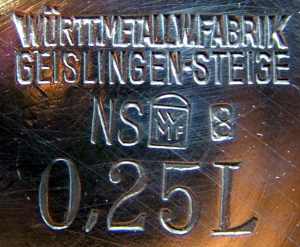

|
Marked by long inscription "WÜRTT. METALLW. FABRIK
GEISLINGEN-STEIGE" and by the abbreviation "WMF" placed
in a beehive with smooth round arch.
The beehive size is from 1.4 x 1.6 mm to 2.2 x2.3 mm.
The size of the arch is from 1.4 x 0.5 mm to 2.2 x1.0 mm.
The additional marks: "NS" means Neusilber (Alpacca),
that is an indication of a base metal for silver plating,
"8" means an amount of silver metal (in grams) used for
silver plating.
This mark was used from 1935 until 1965.
|
|
9
|
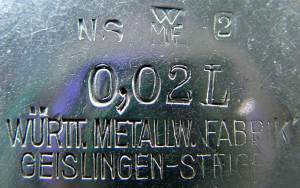
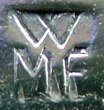
|
Marked by long inscription "WÜRTT. METALLW. FABRIK
GEISLINGEN-STEIGE" and by the abbreviation "WMF", similar
to one used in Mark No.6, but put without a rectangle.
The size of "WMF" is 2.1 x 2.3 mm.
The additional marks: "NS" means Neusilber (Alpacca),
that is an indication of a base metal for silver plating,
"2" means an amount of silver metal (in grams) used for
silver plating.
Note the characteristic shape of the comma in the volume
designation.
This mark was used after 1965.
|
LITERATURE
1. WMF, Württembergische Metallwarenfabrik: Marks - Hallmarks -
History, http://www.silvercollection.it/WMF.html
2. Annette Denhardt. Das Metallwarendesign der
Württembergischen Metallwarenfabrik (WMF) zwischen 1900 und
1930. Historismus – Jugendstil – Art Deco. (Lit Verlag,
Münster, 1993), pp.1-231 [in German].
3. Dedo von Kerssenbrock-Krosigk and Claudia Kanowski, Modern
Art of Metallwork (Berlin: Bröhan Museum, 2001), pp.352-365.
4. Art Nouveau Domestic Metalwork from Württembergische
Metallwaren Fabrik, Reprint of 1906 Catalogue, Second
Edition (Antique Collectors’ Club Ltd., Woodbridge, 2008),
pp.1-392.
Prof. David N. Nikogosyan,
University College Cork, Cork, Ireland
- 2009 -
|
|
|
 ASSOCIATION OF SMALL COLLECTORS OF ANTIQUE SILVER
ASSOCIATION OF SMALL COLLECTORS OF ANTIQUE SILVER ASSOCIATION OF SMALL COLLECTORS OF ANTIQUE SILVER
ASSOCIATION OF SMALL COLLECTORS OF ANTIQUE SILVER